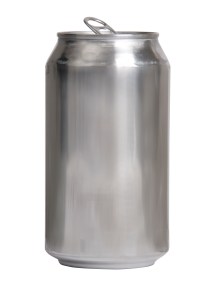Or;
Beer baron’s bold bet beggars bottlers
Some people get wound up about fine wine, others go gaga for The Next Top Model. The 50 merry worthies who gathered at CoorsTek on Washington Street in Golden were excited about something far less glamorous than Carol Alt, but infinitely more valuable than the finest Chateau Margaux ever corked.
After briefly addressing the invitation-only crowd that included three generations of the Coors family, longtime Evergreen resident George Krauss officially presented a large bronze plaque to the venerable man of the hour, Bill Coors, on behalf of ASM International, The Materials Information Society. With that, CoorsTek became the 119th site to be awarded the 38,000-member society’s woefully under-appreciated ASM Historical Landmark Citation, an honor established in 1972 to recognize game-changing milestones in materials technology.
“At this site on January 22, 1959,” the plaque reads, “the first aluminum beverage can plant produced its first can, under the direction of William K. Coors, Joseph Coors and colleagues.”
 Beer cans? All that fuss and feathers for beer cans? You bet, and with very good reason.
Beer cans? All that fuss and feathers for beer cans? You bet, and with very good reason.
“It’s exciting to see what can be done with a fairly common material,” explains Krauss, a former materials researcher at the Colorado School of Mines and one-time ASM president. “The aluminum can is ubiquitous, now, but 50 years ago Bill Coors had to fight against all odds to make it happen. Bringing the aluminum can production to fruition on a large scale was really an event, and it happened right here in Golden.”
Picking up where Krauss left off, William K. related the genesis of the Coors interest in that most  versatile of metals. After World War II, he explained, glass bottles gave way to steel cans, first with awkward cone-shaped tops, and later with sturdy flat lids that required a church-key and strong wrist to breach. While serviceable and convenient, steel cans were relatively difficult and expensive to produce and worse – from a brewmaster’s perspective, anyway – tended to impose its own unwholesome nuance on the golden nectar within.
versatile of metals. After World War II, he explained, glass bottles gave way to steel cans, first with awkward cone-shaped tops, and later with sturdy flat lids that required a church-key and strong wrist to breach. While serviceable and convenient, steel cans were relatively difficult and expensive to produce and worse – from a brewmaster’s perspective, anyway – tended to impose its own unwholesome nuance on the golden nectar within.
Enter Lou Bronstein, a smooth-talking, fast-living, semi-dubious Viennese aluminum broker who, in 1954, persuaded Bill to tour aluminum manufacturing plants and research facilities across Germany. Sold on the possibilities of the strong, light, corrosion-resistant metal, Coors set about trying to generate interest on the home front, but met stout resistance on many fronts, including, ironically enough, American aluminum giant Alcoa, which refused to lend its considerable weight to the venture on the grounds that aluminum beverage cans would never be cost-effective. Undeterred, Coors resolved to make the cans in-house and – 5 years and $10 million later – the seamless, 2-piece, extruded aluminum can made its public debut, a wildly profitable industry was born, and bottle manufacturers around the globe sleeping late and muttering to themselves.
 “We make literally billions of these things,” Krauss says. “Soda pop, sports drinks, beer, juice – everything comes in aluminum cans. Ball Corporation has another huge aluminum can plant in Golden. They’re perfect beverage containers.”
“We make literally billions of these things,” Krauss says. “Soda pop, sports drinks, beer, juice – everything comes in aluminum cans. Ball Corporation has another huge aluminum can plant in Golden. They’re perfect beverage containers.”
They are that. Feather-light, tough as nails, aluminum conducts heat like nobody’s business, meaning it cools liquids faster and keeps them cold longer than other materials. Best of all, it’s 100-percent recyclable, making it both more economical to manufacturer and less burdensome to the common ecology.
 Just for the record, CoorsTek is the second Colorado institution to receive ASM’s approbation. In 1977, the Climax Molybdenum Mine and Mills Complex near Leadville got the nod, joining such stellar industrial lights as the Outokumpu Flash Smelter in Helsinki-Espoo, Finland, the Forge of Fontenay in Bourgogne, France, and the world’s first attack submarine, the American civil war vessel H.L. Hunley, a modern marvel of its time that was recently resurrected from a watery grave off the coast of South Carolina.
Just for the record, CoorsTek is the second Colorado institution to receive ASM’s approbation. In 1977, the Climax Molybdenum Mine and Mills Complex near Leadville got the nod, joining such stellar industrial lights as the Outokumpu Flash Smelter in Helsinki-Espoo, Finland, the Forge of Fontenay in Bourgogne, France, and the world’s first attack submarine, the American civil war vessel H.L. Hunley, a modern marvel of its time that was recently resurrected from a watery grave off the coast of South Carolina.
Niceties accomplished, the assembled can-fans dug into a cake fashioned in the likeness of – what else – an aluminum Coors beer can, and then toasted William’s bold gamble with – you guessed it – aluminum cans of Coors beer. More fitting tributes can hardly be imagined.
 “Aluminum can technology was a huge step forward,” says Krauss. “It took one man with the vision to see that aluminum cans were worthwhile.”
“Aluminum can technology was a huge step forward,” says Krauss. “It took one man with the vision to see that aluminum cans were worthwhile.”











